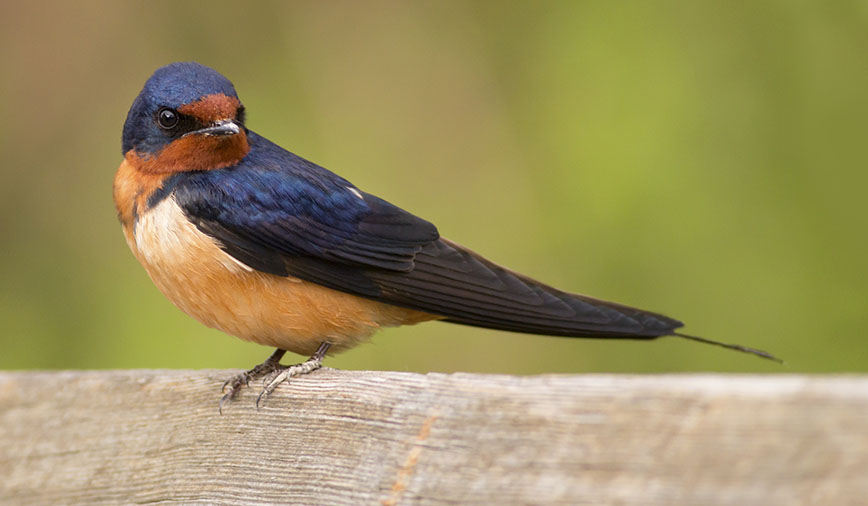September 12, 2014 Barn Swallows
A barn swallow rests on a lichen-covered branch. Barn swallows typically make their homes near humans, a trait that has helped them become the most prolific swallow species on the planet. Photo provided by Kane County Audubon president Bob Andrini.
The neighbor’s kids were out the other day, chattering excitedly as they soaked up some late-summer sun. It was snack time – seems like it’s always snack time with these guys – and the four of them jostled each other as they gathered together and waited expectantly for their treats to arrive.
Finally Mom, or maybe it was Dad, or possibly an older sibling (I’ll admit, I really can’t tell them apart) showed up with a little nosh, and the ravenous quartet went absolutely nuts. The little guy closest to me made a grab, but the prize – something with wings – went to one of the youngsters in the middle.
Mom, Dad, whichever, took off again almost immediately, leaving the youthful clan seemingly unattended. But it wasn’t long before another small meal arrived and was stuffed down a gaping gullet.
I suppose now’s just as good a time as any to mention that the four kids, lined up along a branch near the garden plots at James O. Breen Community Park, are probably only a month or so old, not counting the time they spent in their eggs. I should also probably point out that they’ll be leaving, very soon, on a journey that will take them as far away as South America.
And, yeah, I guess I should also mention that our spirited neighbors are barn swallows.
If you happen to live near water, or in an area that used to be open farmland, chances are you have barn swallow neighbors too. These gregarious birds, named after their propensity for nesting in barns, build their mud nests under the eaves of sheds and houses, on porches, under bridges … If it’s a sturdy structure and has lots of insects flying nearby, it’s a good home for barn swallows.
Historically, barn swallows nested in caves – a geologic feature that, you may have noticed, is in short supply here in northeastern Illinois (with the notable exception of Devil’s Cave in North Aurora, which plays host to thousands of school kids, and a pair of northern rough-winged swallows, each year).
But humans provided the birds with a whole new range of options for nesting. There are anecdotal reports of barn swallows building
nests on Native Americans’ summer longhouses hundreds of years ago.
Then, as European settlers began arriving, wham, bam! It was Fat City for li’l Hirundo rustica. Log cabins and houses soon were followed by the structures that gave the birds their common name: barns. These big buildings provided acres of vertical surface area just right for affixing mud and grass – the swallows’ primary building materials. Even better, because many predators shied away from places people populated, barn swallows enjoyed, and still benefit from today, the rare treat of rearing young in relative safety.
By aligning themselves with what is arguably the world’s most invasive mammal, barn swallows have become the world’s most abundant swallow species. They breed in North America, Europe and Asia and overwinter in Central and South America, Africa and even northern Australia. Population estimates put their numbers at around 190 million.
That’s a lot of barn swallows. And, while some folks may feel otherwise, I think having a lot of barn swallows is a good thing. They eat bugs by the bazillions. They’re fascinating to watch. They build mud nests with their mouths – no hands required. And, for all you beginning birders out there, they’re easy to identify. No other swallow species has a long, v-shaped, scissor-like tail like that of the barn swallow.
If you haven’t done so already this year, try to put some time aside to head out to a nearby barn swallow-viewing site. The athletic fields at James O. Breen are good, especially if the mowers are out and churning insects in their wake. Pottawatomie Park, by Anderson’s Paddlewheel Riverboats, is another great spot to stand, or sit, and watch the birds and their aerial antics.
But don’t wait too long. South America is a long way away and, even now, the swallows are gathering in preparation for their trip. If you miss them you’ll have to wait another seven or eight months before they’ll be back again. To go that long without a glimpse of one of our most entertaining summer visitors… that’s a prospect that’s hard to, well…
Swallow.
Pam Erickson Otto is the manager of nature programs and interpretive services at the Hickory Knolls Discovery Center, a facility of the St. Charles Park District. She can be reached at 630-513-4346 or potto@stcparks.org.

